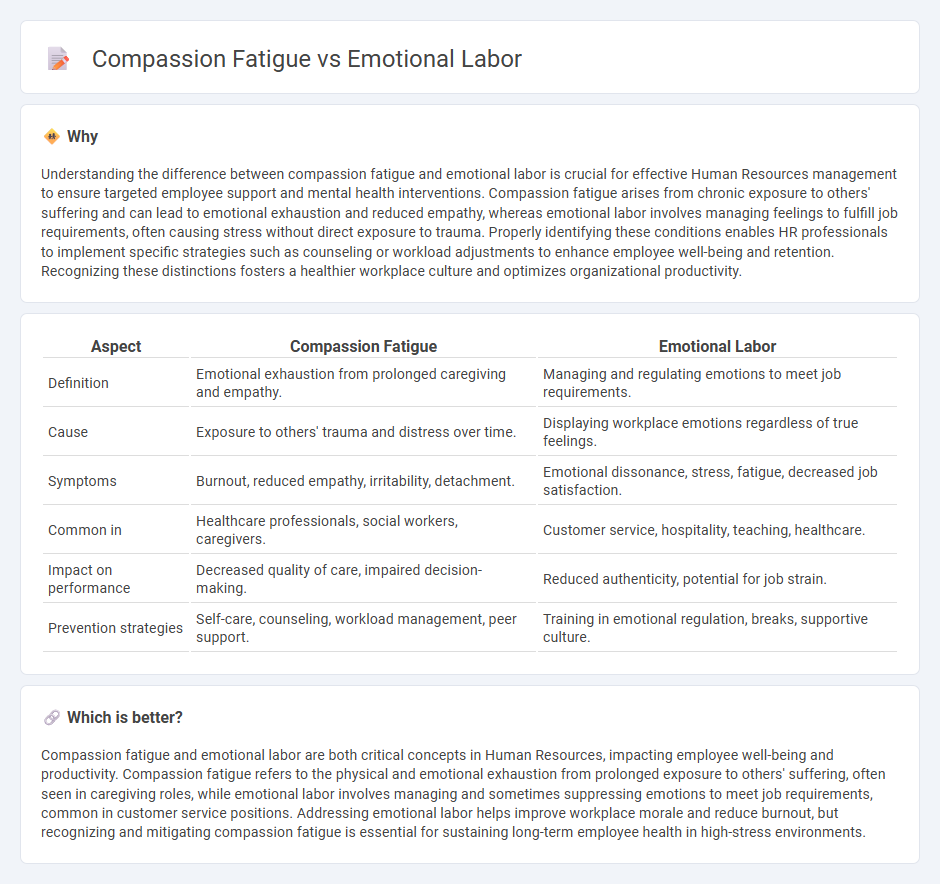
Compassion fatigue and emotional labor are critical concepts in Human Resources impacting employee well-being and productivity. Compassion fatigue refers to the emotional exhaustion from continuous exposure to others' suffering, while emotional labor involves managing feelings to meet organizational expectations. Explore how understanding these challenges can improve workplace support and employee retention strategies.
Why it is important
Understanding the difference between compassion fatigue and emotional labor is crucial for effective Human Resources management to ensure targeted employee support and mental health interventions. Compassion fatigue arises from chronic exposure to others' suffering and can lead to emotional exhaustion and reduced empathy, whereas emotional labor involves managing feelings to fulfill job requirements, often causing stress without direct exposure to trauma. Properly identifying these conditions enables HR professionals to implement specific strategies such as counseling or workload adjustments to enhance employee well-being and retention. Recognizing these distinctions fosters a healthier workplace culture and optimizes organizational productivity.
Comparison Table
| Aspect | Compassion Fatigue | Emotional Labor |
|---|---|---|
| Definition | Emotional exhaustion from prolonged caregiving and empathy. | Managing and regulating emotions to meet job requirements. |
| Cause | Exposure to others' trauma and distress over time. | Displaying workplace emotions regardless of true feelings. |
| Symptoms | Burnout, reduced empathy, irritability, detachment. | Emotional dissonance, stress, fatigue, decreased job satisfaction. |
| Common in | Healthcare professionals, social workers, caregivers. | Customer service, hospitality, teaching, healthcare. |
| Impact on performance | Decreased quality of care, impaired decision-making. | Reduced authenticity, potential for job strain. |
| Prevention strategies | Self-care, counseling, workload management, peer support. | Training in emotional regulation, breaks, supportive culture. |
Which is better?
Compassion fatigue and emotional labor are both critical concepts in Human Resources, impacting employee well-being and productivity. Compassion fatigue refers to the physical and emotional exhaustion from prolonged exposure to others' suffering, often seen in caregiving roles, while emotional labor involves managing and sometimes suppressing emotions to meet job requirements, common in customer service positions. Addressing emotional labor helps improve workplace morale and reduce burnout, but recognizing and mitigating compassion fatigue is essential for sustaining long-term employee health in high-stress environments.
Connection
Compassion fatigue, a state of emotional exhaustion from prolonged exposure to others' suffering, directly links to the concept of emotional labor, which involves managing and often suppressing genuine emotions to meet workplace expectations. In human resources, understanding this connection is crucial for developing support systems that help employees maintain mental resilience and prevent burnout. Implementing strategies like regular debriefing sessions and promoting emotional well-being can mitigate the negative impacts associated with both compassion fatigue and emotional labor.
Key Terms
Emotional Regulation
Emotional labor involves managing feelings to fulfill professional roles, requiring consistent emotional regulation that can lead to stress and burnout. Compassion fatigue results from prolonged exposure to others' suffering, depleting emotional resources and impairing empathy. Explore effective emotional regulation techniques to mitigate the impacts of both emotional labor and compassion fatigue.
Burnout
Emotional labor involves managing and suppressing emotions to meet job expectations, often leading to burnout due to prolonged stress and emotional dissonance. Compassion fatigue, a form of secondary traumatic stress, results from continuous exposure to others' suffering, causing emotional exhaustion and reduced empathy, which significantly contributes to professional burnout. Explore key strategies to mitigate burnout stemming from both emotional labor and compassion fatigue in caregiving professions.
Empathy
Emotional labor involves managing feelings and expressions to fulfill the emotional requirements of a job, often requiring sustained empathy, whereas compassion fatigue refers to the physical and emotional exhaustion resulting from prolonged exposure to others' suffering. Empathy plays a critical role in both, as it fuels emotional labor but can also lead to compassion fatigue when emotional boundaries are not maintained. Explore more about balancing empathy to prevent burnout and enhance emotional resilience.
Source and External Links
Emotional labor | EBSCO Research Starters - Emotional labor is the effort required to manage one's emotions to meet the demands of a job or social role, often involving displaying prescribed feelings regardless of one's true state, and is especially prominent in service industries but also extends to unpaid domestic and care work, with the burden often falling disproportionately on women and marginalized groups.
Emotional Labor: Examples & Consequences - Emotional labor refers to managing and regulating one's emotions and outward expressions, especially when interacting with customers or clients, and while it can help maintain social harmony, frequently suppressing authentic feelings can lead to emotional exhaustion and psychological distress.
Emotional Labor in Relationships: The Invisible Weight - Emotional labor in personal relationships involves the ongoing, often invisible work of anticipating needs, managing conflicts, and coordinating tasks to maintain harmony and comfort for others, which can be mentally exhausting and typically goes unrecognized.
 dowidth.com
dowidth.com